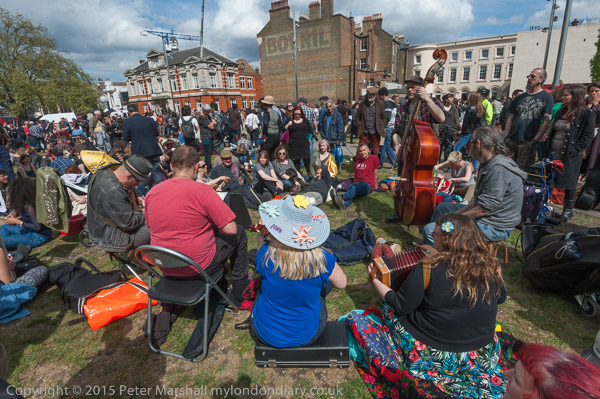Fighting Brixton Gentrification – On Saturday 25th April 2015 the local community in Brixton held a day of activities to reclaim its social & cultural diversity, threatened by increasing rents and property development that are forcing out local businesses and residents.

I’d arrived early for main ‘Reclaim Brixton’ event in Windrush Square and first made my way to Atlantic Road where long-established local businesses were being forced out from the railway arches which line one side of the road. They were under threat from Network Rail who with support from Lambeth Council were carrying out a refurbishment programme which would result in their shops being closed and the rents for the shops after being three times as high, pricing the low cost local businesses out of the area.

All the stores were closed for two hours across lunchtime in protest, and mural artists had been invited to work on their metal shutters. In 2015 I wrote: ‘On Stella’s Exclusive Hair & Beauty Salon an artist was working on a mural for the United Families and Friends campaign, celebrating Cherry Groce, Sean Rigg and Ricky Bishop, all killed by Brixton police. All the shops on both sides of the arches were closed, and most had white sheets with the name of the business and a punning message about the evictions. Some of them have traded here for many years – Denmay Fabrics since 1948, and L S Mash and Sons have been fishmongers here since 1932. Their message to Network Rail – ‘Don’t rip the soul outta my place”


Street theatre groups walked past on their way to ‘Reclaim Brixton’ some in exotic dress carrying cardboard homes and others with posters against the threat to Communities, Homes, Businesses from Lambeth Council.

I walked along to the gentrified Brixton Village, an extensive arcade between Atlantic Road and Coldharbour Lane, to find that police and security were keeping out protesters who, led by London Black Revs, had planned to go through the market in a peaceful march.

I found Class War at Brixton Station and walked back with them to Brixton Village, where other campaigners including some from the Ayslesbury Estate where I had photographed the previous day making their banner and other South London housing campaigners were arriving for the march.

Rather to my surprise the march when it finally started was a short and fairly direct one to Windrush Square, turning off Coldharbour Lane to enter the square via Rushcroft Road.

Close to the mansion flats which had been squatted for 32 years before residents were violently evicted in July 2013 people accompanying the long black banner of B.A.G.A.G.E (Brixton Action Group Against Gentrification and Evictions) with its message ‘Refuse to Move – Resist the Evictions – Support your Neighbours’ and others let off several red flares.

Windrush Square in front of the Tate Library and opposite Lambeth Town Hall was a few years earlier re-landscaped by Lambeth Council, who deliberately turned what had been a popular place for locals into a bleak and unwelcoming windswept area to discourage the informal gatherings that took place there.

Perhaps it was partly due to this that the event taking place there seemed to lack any real cohesion with various groups doing their own thing in different parts of the large area and largely ignoring the speeches and performances at the Unite Community stage.

After an hour or so with not very much happening, activists decided it was time for a march and took to the road blocking traffic and walked up Brixton Road.

They stopped for a while outside Brixton Underground, drumming and dancing and shouting.

Then they marched along Atlantic Road and rather to my surprise returned directly to Windrush Square along Coldharbour Lane.


I hung around for a while in Windrush Square where nothing much was still happening slowly and things seemed peaceful. I decided I had done enough for the day and left.

This was a mistake. Shortly after (probably when Class War came out of the pub) sthings kicked off and some people stormed and briefly occupied Lambeth Town Hall, a large window at Foxton’s estate agents was broken, and a few activists went into Brixton Village with banners.
Many more pictures on My London Diary:
London Black Revs ‘Reclaim Brixton ‘march
Reclaim Brixton celebrates Brixton
Take Back Brixton against gentrification
Brixton Arches tenants protest eviction
Flickr – Facebook – My London Diary – Hull Photos – Lea Valley – Paris
London’s Industrial Heritage – London Photos
All photographs on this page are copyright © Peter Marshall.
Contact me to buy prints or licence to reproduce.


























